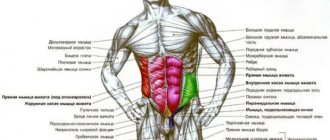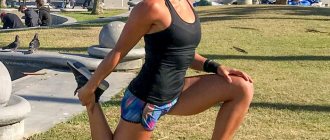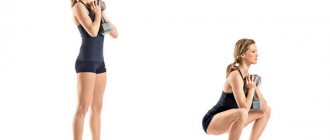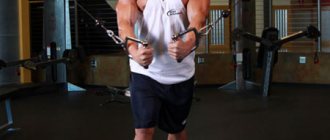Lower back pain is one of the most unpleasant sensations a person can experience. It literally immobilizes you and doesn’t allow you to think about anything else. According to statistics, a third of the adult population suffers from back pain at least sometimes, and over the years this figure is only growing. Fortunately, even with a sedentary and sedentary lifestyle, discomfort can be kept to a minimum.
We'll tell you about three simple exercises to get rid of discomfort in the lower back. They are easy to perform, they do not take much time, but the effect will exceed all expectations.
Don't crunch your vertebrae: 3 simple exercises for neck pain
Neck discomfort is not only inconvenient, but can also be dangerous. Luckily, it's not that difficult to deal with.
In what cases are exercises indicated for relieving back pain?
It is advisable to eliminate lower back pain at home after finding out the cause of its occurrence. This symptom is characteristic of many diseases of internal organs - cystitis, cholecystitis, pyelonephritis, prostatitis, uterine fibroids. This requires complex treatment, and physical education is indicated only during rehabilitation.

You can get rid of pain in the lower back with the help of exercises if you have osteochondrosis, spondyloarthrosis, protrusion, or intervertebral hernia. Certain sets of exercises have been developed for exercises during remission and during exacerbations of these pathologies. In the latter case, they are usually performed in the presence of a doctor who controls the load.
Efficiency of classes
Daily physical exercise is the most effective method of treating degenerative diseases of the lumbar spine. By taking analgesics and muscle relaxants, it is only possible to get rid of symptoms temporarily. And doing the exercises allows you to take a comprehensive approach to solving back problems:
- strengthen muscles, stabilize discs and vertebrae in a physiological position;
- improve blood supply to bone, cartilage, soft tissues with nutrients;
- reduce the severity of pain or completely get rid of it.
Building up a muscle corset helps prevent disc displacement, pinching of blood vessels and spinal roots by them and bone growths. Therefore, gradually, along with the pain, other symptoms of osteochondrosis or spondyloarthrosis - sensory disturbances, stiffness of movement, paresthesia - disappear.
General execution rules
The room should be well ventilated before training. But it should not be cool in it, otherwise there is a risk of catching a cold in the lower back. For exercise, you need to choose clothes made of breathable materials that absorb moisture well. It is also necessary to follow the recommendations of exercise therapy doctors :
- make movements smoothly, a little slowly;
- increase the pace gradually, do not try to complete all the exercises in the first lessons;
- If pain occurs, stop training and resume it only after a long rest.
It is important to listen to the sensations that arise. If after performing a certain exercise the pain intensity decreases noticeably, then it should be repeated more often.
Recommendations for performing exercise therapy for the back
In order to avoid damaging your health when performing exercise therapy for the back, rehabilitation experts advise adhering to the following recommendations:
- do not overcome pain while performing exercises;
- do not work with weights (dumbbells or barbells);
- avoid drafts during classes;
- do not overload the body and do not perform physical therapy exercises for the back too many times (start with 4-6 times for each movement, do gymnastics 2 times a day);
- do not engage in exercise therapy during exacerbation of osteochondrosis and severe back pain;
- During classes, monitor your posture (your back should be straight and level);
- Make all movements slowly, without jerking;
- if physical therapy causes back pain, stop immediately;
- alternate difficult workouts with relaxation exercises.
Start exercise therapy for your back with simpler movements and, having mastered them, move on to complex exercises.
Relieving acute lumbar pain
An attack of lumbago manifests itself as acute pain in the lower back. It is so piercing and burning that a person cannot even get to bed without assistance. Therefore, at this time there can be no talk of any activities. They begin several hours and even days after the severity of pain has subsided.
Pose "Cat-cow"
Get on all fours, simultaneously lower your head and round your back. Return to the starting position, bend your lower back, lifting your chin. The number of approaches is 5-7. Some soreness after an attack of lumbago is quite natural. But when it becomes stronger, a long rest is required.
Child's pose
Get down on your knees wide apart so that your feet touch each other. Stretch your arms in front of you and move your body forward with a sliding movement, touching your forehead to the gymnastics mat. Stay in this position for 10-15 seconds, return to the starting position. Repeat the exercise 4-5 times.

Exercises with a chair
Kneel down in front of a stool or chair, trying to keep your back straight. Place your hands on the seat for support. Smoothly bend and bend your lower back 8-10 times. In the same body position, bend first in one direction, then in the other direction. When performed correctly, the exercise places the main load on the lateral muscles of the back, not the lower back.
Lying stretch with torso turning left and right
Lie down, straighten your legs, spread your arms to the sides. As you inhale, bend your knees and turn them to the right, holding this position for 5 seconds. Exhale, return to the starting position. Repeat the movements 5 times, then perform the exercise in the other direction.
Torso rotations from a sitting position
Sit on the mat, bend your right knee and bring it behind your straightened left leg. To maintain balance, lean on the floor with your right hand. Turn to the left, using your free palm to lightly press on your knee. Perform the exercise 3-5 times in each direction.
Stretch "Shell"
Get on all fours, take a deep breath and lower your buttocks onto your heels, without lifting your palms from the floor. Stretch well, tensing the muscles of the lower back, take the starting position of the body. The number of approaches is 5-10.
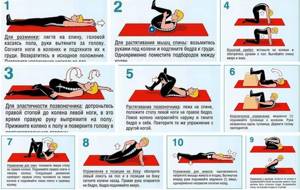
Exercises to Reduce Pain

The entire complex is carried out at a slow pace. Breathing is free.
- Lie on the floor, on your back, with your knees bent. Raise your pelvis and stay in this position for several seconds. Exhale and slowly lower yourself to the starting position.
- Roll over onto your stomach, place your arms along your body, palms up. Raise your head, shoulders and legs at the same time. The body should resemble a boat. This exercise relieves pain from the sacrum and lower back.
- Lie on your back. Bend your left leg at the knee and pull it towards your chest with your arms. Repeat with your right leg, then bring both legs to your chest. Stay in this position for a couple of seconds, rocking on your back.
- Stand straight, clasp your palms behind your back and press them onto your lower back.
- Stand in front of the mirror, rise on tiptoes. Hold this position for several seconds.
- Sit on a chair, grab the bottom edge with your hands, press harder and lean forward and back. The exercise will relieve congestion from the back and improve nutrition in the discs. Suitable for people who often sit at work.
- Sit down, place your hand on one knee and apply pressure, then do the same with the other hand and knee. You can press with both hands at the same time. This will relieve tension in your back.
- Stand in a knee-elbow position. Slowly lower yourself onto your buttocks, touching your heels. Repeat 5 – 7 times.
Additional complex
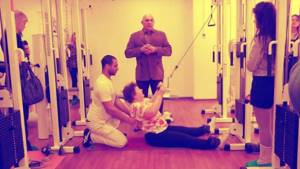
There are a number of exercises according to Bubnovsky. This doctor has developed special training for back and lower back pain.
- Walk on all fours - a simple exercise, but it shows excellent results.
- Before you begin the exercise, lie down on the floor and relax. Bend your knees, hands behind your head, clasped in your palms. Prepare a cold compress and place it under your lower back. Now simultaneously lower your head to your chest and pull your legs up. Elbows should touch knees.
- The third lesson is the half bridge. To do this, stay in the same position as in the previous exercise. Place your arms parallel to your torso. Raise your pelvis, do it as high as possible.
- Stand straight with your feet wider than shoulder-width apart. Lower yourself to your right and left legs with your back straight. The knees must not be bent.
- Hang from the horizontal bar. Bend your knees and lift them towards your chest. More advanced people can do straight leg raises.
Relief of moderate lower back pain
Moderate lower back pain often precedes exacerbation of spondyloarthrosis or osteochondrosis. To eliminate them and prevent relapses, exercises are used to stretch the muscles of the entire back.
Wall Squats
Rest your back against the wall, spread your feet shoulder-width apart, clasp your fingers and place them in front of you at chest level. Slowly perform a shallow squat, hold in this position for 10 seconds, and return to the starting position. Repeat all movements 5-7 times.
Low back flexor stretch
Lie down with your knees bent and your feet on the floor. Pull one leg towards your chest, clasping the back of your thigh with your hands. Stay in this position for 10-20 seconds, take the starting position. Repeat 5 times, perform the exercise with the other knee, and then lift both legs at once.
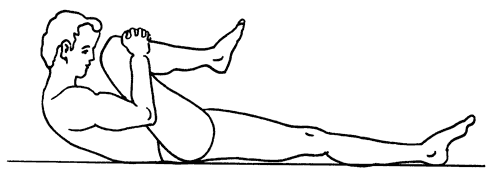
Hyperextension
Lie on your stomach, bend your arms, placing your palms near your shoulders. Taking a deep breath, raise your upper body for 10 seconds. As you exhale, lower yourself to the floor. The number of approaches is up to 10. When performing the exercise correctly, the muscles of the lower back, not the shoulder girdle, should be tense.
Exercise to correct pelvic tilt
Lying on your back with your legs raised straight, press your lower back firmly into the mat. Slowly lower your legs down. Bend your knees only when your lower back begins to lift off the floor. Perform the exercise 10-15 times.
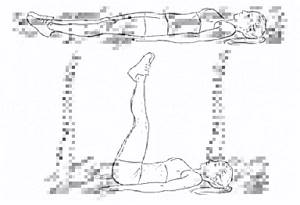
How to warm up your muscles

Before any set of exercises, you should do a warm-up to warm up the joints and ligaments. This will prepare your back for a set of exercises.
- Rotate your pelvis - stand straight, feet slightly wider than shoulders. Hands are placed on the lower back. Make circular movements to the right and left. Repeat several times.
- Bends to the side will stretch the muscle fibers. The exercise is done at a slow pace. Stand up straight, join your palms and bend towards your right and left feet alternately. During the exercise, fix your hands on the floor, between both feet, and hold for a couple of seconds. Return to normal position.
- Lift-ups – Lie on your chest on a hard surface. Straighten your arms, placing them behind your head. Lift your upper body using your back muscles. Fix the maximum position at the top point and lie on your stomach.
You need to repeat at a slow pace eight to ten times.
Other exercises
It is easier to prevent the appearance of lower back pain than to eliminate it for a long time, including with medication. For this purpose, a set of exercises has been developed, the implementation of which becomes an excellent prevention of exacerbation of pathologies of the musculoskeletal system. During training, the muscles become more elastic, which contributes to the correct distribution of loads on all parts of the spine.

Roller rolling for the lower back
Sit down with your knees slightly bent, place a gymnastic roller behind your back, straighten your arms and place them behind your back. Place your palms on the floor, raise your buttocks and sit on the cushion. Slide it back and forth for 5-10 minutes. Try to place the load on the muscles of the back and abdominals, and not on the arms and legs.
Downward Facing Dog Pose
Take a horizontal position, rest your toes and palms on the floor, as before performing gentle push-ups.
Raise your pelvis slightly and at the same time lower your head, trying to touch your forehead to the floor. Stay in this position for 10 seconds, return to the starting position. Repeat all movements 10 times.
Bird Dog Pose
Get on all fours, lift your left arm and right leg together. Stretch for 15 seconds, feeling the tension in the muscles of your entire back. Get down on all fours and repeat the exercises with your right arm and left leg. Number of approaches - up to 20.

Raising the pelvis on a bench
Sit in such a way that the bench is at a distance of 35-40 cm from the buttocks. Place your arms straight on the seat of the bench, bend your legs. As you inhale, raise your lower back parallel to the floor, resting your feet on the mat. After 10 minutes, return to the starting position. Perform the exercise 10 times.
Stretching the back and leg muscles
Lie down, bend your knees, place your feet shoulder-width apart. Cross your left leg behind your right until your ankle touches your knee. Pull your left knee as close to your chest as possible, helping with both hands. Repeat the exercise 5 times, then perform in the other direction.
Strengthening your back muscles at home
If your goal is a comfortable life without problems with the musculoskeletal system, then you can train at home. It is enough to create a set of 2-3 exercises and perform them at least 2 times a week, in the morning, as exercise, or after a working day.
Exercises:
Boat or extension lying on your stomach. It works well not only the lower back, but also the upper back and buttocks.
If you find it difficult to keep your arms in front of you, spread them out to the sides like an airplane. An even easier option is to place your arms along your body.
Tilt the body forward. The correct bending technique is to bend the torso at the hip joint. At the same time, the lower back should maintain a natural deflection! You can put your hands behind your head in a lock, or stretch them forward, as in the previous exercise. This will increase the load on your back muscles.
Hyperextension on a fitball. For a more stable position, place your feet slightly wider than shoulder-width apart. Use non-slip surfaces to prevent your feet from slipping backward. You can rest your heels against the wall.
When performing the movement at the lowest point, a slight deflection in the lower back is allowed. With further extension, the lower back should take a natural deflection and in this position move to the top point of the amplitude
Physiotherapy
As a supplement to the main training, you can use exercises from the arsenal of rehabilitation doctors. And if you already have back problems, then this complex should be used as the main one. After consulting your doctor first.
Stretching while lying down. Lie on your back, stretch your arms behind your head. Then bend your knees and pull them towards your chest. Stay in this position for a few minutes. Return to the starting position.
Exercise "cat". Stretches the back and abdominal muscles well. Use it as a warm-up.
Lie on your back. Touch your left foot to the knee of your right leg. Extend your left arm above your head, along the floor. With your other hand, press the knee of your left leg toward the floor. Feel the stretch in your obliques and lower back muscles.
Various lifts of arms and legs. By practicing this exercise, you will strengthen the entire muscular corset (core), which includes, among other things, the buttocks and abdominals. In the starting position, stand on all fours. Then extend the opposite arm and leg. Try to keep your pelvis motionless. This way you engage the deep-lying muscles: the quadratus lumborum and the transverse abdominis.
Perform all exercises for 10-15 repetitions in 2-3 approaches. Or in the form of circuit training, doing 2-3 circles. Rest between sets until your heart rate returns.
Relieving lower back pain during pregnancy
During pregnancy, lower back pain is usually due to natural causes - an enlarged uterus, compression of the pelvic organs. Doctors recommend doing the following exercises to relieve it:
- Lie on your back, bend your legs, extend your arms along your body. Slowly lift your buttocks off the floor and, without staying in this position, lower yourself to the floor;
- stand up, clasp your fingers in front of you, spread your elbows to the sides. Make turns from side to side. Perform the exercise again, only now joining your palms behind your back;
- kneel down, place your hands on the floor. Lower your buttocks first onto one heel, then onto the second.
Repeat all movements 5-10 times. After class, you should lie down for 3-40 minutes and relax. This is especially true in late pregnancy.
The best exercises for back and lower back pain
After the warm-up has been completed, you can move on to the main complex. In time, it should occupy at least two quarters of the total warm-up duration. The following types of activities are considered the most useful and safe:
- Take a knee-elbow position with emphasis on your knees and palms. Straighten your left arm, raising it in front of you. Also straighten, lift, and stretch your right lower limb. Stay static at the maximum stretch points for a few seconds, now take the original position, do the exercise with changing limbs. Do the complex 5-7 times;
- Lie on your back on a soft yoga mat. Straighten your legs, straighten your arms along your body. Bend your knees, slowly begin to pull them up to your chest at the same time, as soon as you can - hug them, help yourself in this way. At the point of the tightest compression, fixate for 5 seconds, then take the original position, do it 6 times;
- Take the initial position lying face up, upper limbs straightened parallel to the body, lower limbs extended. Tightening the muscles of the lower back and abs, lift your body, lifting your back from the support. In this pose, make small turns of the body, first to the left, then to the right, take the original position. Do 6 times;
- Passive hanging turns on the horizontal bar. Grab the bar, weigh on the horizontal bar as long as possible, turning your body left and right. Then release the horizontal bar and take a break. Perform at least 3 sets;
- Upper body rotations are performed from the starting position facing up. The upper limbs are extended along the body, the lower limbs are straightened. Raise your left shoulder from the support, trying to turn your body as far as possible to the right, without interrupting the contact of your hips with the floor. At the maximum point of the position, fixate for 3-4 seconds, then return to the original position. Do the complex in the other direction (do 5 times for both sides).
Any exercises for the lower back for lower back pain should not cause discomfort. Do it as many times as possible without feeling tired.

Bubnovsky's technique
Classes using Dr. Bubnovsky’s method are conducted in medical centers equipped with special simulators. Rehabilitation doctors monitor movement techniques and help perform exercises with resistance. S. Bubnovsky is a famous chiropractor, the author of a method for getting rid of pain without taking pharmacological drugs. He recommends performing the following exercises for both therapeutic and preventive purposes:
- get on all fours and slowly move along the gymnastic mat, putting forward first your right arm and left leg, then your left arm and right leg;
- Lie on your back, bend your legs slightly, clasp your fingers, place your head on them. Place a thin, dense pillow under your lower back. Exhale, say “Ha” loudly, raise your shoulder blades and knees at the same time, trying to bring them as close as possible to each other;
- lying on your back, bend your knees, stretch your arms along your body. Exhale, say “Ha,” raise your pelvis, squeezing your buttocks. As you exhale, return to the starting position.
The number of repetitions is 10-12. In S. Bubnovsky's clinics, instead of pillows, they usually place bags of crushed ice under the lower back, which are placed in cases made of thick fabric.
Contraindications to gymnastics
Performing exercises to relieve pain is prohibited if you feel generally unwell. Contraindications to gymnastics are elevated body temperature, chills, cold sweat - the main signs of general intoxication of the body. Exercise therapy doctors prohibit exercising with high or sharply decreased blood pressure, tachycardia, or bradycardia.

